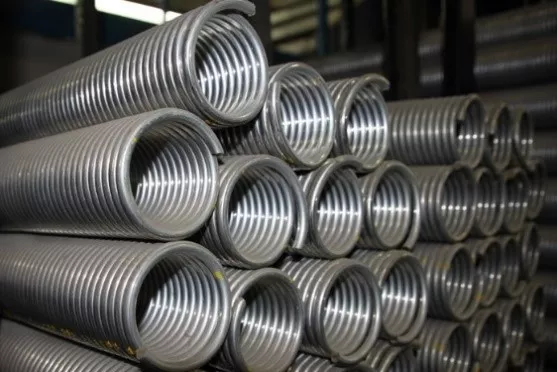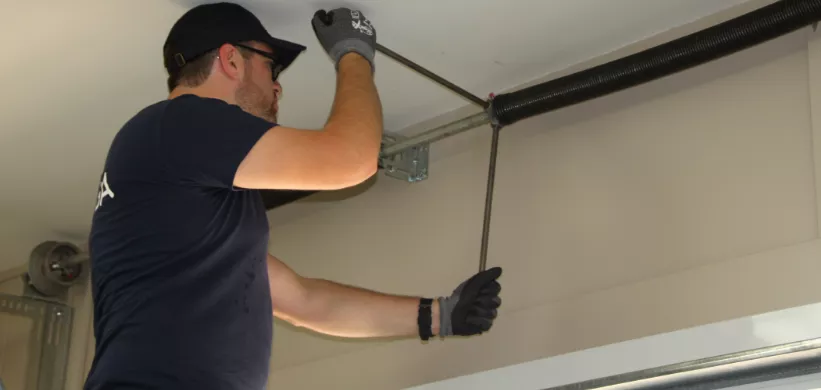This isn’t one of life’s great questions, so most likely it doesn’t come up… unless you’re thinking about buying a new garage door system, or a spring you have breaks. Placed inside the garage, the spring system is responsible for counterbalancing the weight of your garage door, and a correctly balanced door allows you to open it manually without straining, or an electric door opener to do the same easily.
The spring system is a major component of your garage door system and it’s important to pay special attention to it.

One or two fundamentals, before we get started
When talking about sectional overhead garage doors, there are two types of springs: the extension type and the torsion type. The former is installed over the horizontal tracks while the latter is located over the head of the door.
Which one do we see most often on the market? That would be the torsion type because of its three important advantages: it’s quieter, safer and works better.
- Quiet: because it is affixed to the wall over the door and not over the tracks, thus there is very little transmission of noise when the door is operated.
- Safe: as the spring is inserted in a shaft, if the spring breaks, it will stay attached to this shaft. In the other case, with extension springs, if they aren’t fitted with a safety cable, then when one spring breaks, it will surely hit the wall and do a lot of damage to any car found in the garage.
- Operation: all of the energy, meaning the weight of the door, is transferred to the center of the door, onto the anchor plate of the shaft, meaning the door opens smoothly and in a balanced manner. If you have an extension system, the two springs, one above each track, lift the door independently, and if the door isn’t properly adjusted, you could feel shaking or vibrations when the door opens.
How does it work?
To begin with, it must be understood that torsion springs have many uses, and they are found everywhere. Shaped like a coil, a torsion spring is a spring that works by torsion or twisting, storing mechanical energy to ensure that the door can be easily lifted manually or with an electric door opener. As you can see, we are far from the "counterweight" systems that were seen in the sixties.
The spring system doesn’t work alone
If you’ve ever taken the time to see how a torsion spring system works, you probably realized it doesn’t work independently. The spring is first inserted in a shaft which is held in place by a central plate firmly mounted to the wall. Next, the shaft is connected to a grooved drum which the lifting cable is wound around. This cable, in turn, is attached to the bottom section of the door by a bracket solidly screwed onto the door. Everything is interrelated: bottom bracket + lifting cable + drum + shaft + spring. When the door is closed, the weight - or energy - of the door and its system is transferred to the spring. When the door is in its open position, the spring system is relaxed.
Your next question is most likely “How much does a garage door weigh?” Here are two reference points:
- For a 1 ¾"-thick steel door, insulated with polyurethane foam: about 2 lb. per square foot (if there are windows, add the weight of each window, about 2 ½ to 3 lb. per window), meaning:
- 9 x 7 ft. = around 150 to 160 lb. (68 to 73 kg)
- 16 x 7 ft. = around 280 to 295 lb. (127 to 135 kg)
- For a 2"-thick steel door, non-insulated : about 1 ½ lb. per square foot, meaning :
- 9 x 7 ft. = around 125 to 130 lb. (57 to 59 kg)
- 16 x 7 ft. = around 280 to 295 lb. (102 to 107 kg)
Some quick Q&A…
To help in satisfying your curiosity, there are some quick questions and answers that are often asked about torsion springs:
-
Is the spring for a single door always installed on the left when viewed from the inside?
No. Manufacturers produce just as many springs to be installed on the right as the left. The position changes nothing about the correct functioning of the door.
-
One or two springs?
In most cases, single doors (often 9 x 7 ft.) have only one spring, and double doors (for example 16 x 7 ft.) have two of them.
-
How long does a spring last?
Manufacturers normally supply springs rated for 10,000 cycles. One cycle equals one opening and one closing. Therefore, if you use your door 2 to 3 times a day, the spring will function for about 7 years. It should be noted that torsion springs lose their strength over time. If you use your door more often, be aware that certain dealers carry springs that have a rating of 20,000 to 25,000 cycles.
-
Are springs galvanized?
On average, springs contain about 35 to 40% galvanization (zinc) to protect against rust. If your garage is extremely humid, be aware that there exist fully galvanized torsion springs.
-
Is there a way to extend the life of a spring?
Under normal use, if you perform regular lubricating of all metal parts that come in contact with each other, which includes hinges, metal rollers and of course the spring system, this will protect them against premature corrosion. Lubrication also eliminates noise when spring coils rub against each other. Use a petroleum-based lubricant.
-
How can I tell if my torsion spring is effective?
You have to operate your door manually. If you have an electric garage door opener, deactivate it and try to lift your door. It should only weigh between 8 to 10 lb. (3 to 5 kg) and you ought to be able to lift it with only one hand, without straining yourself.
-
Is a torsion spring always placed in front?
No. If the headroom over the door is less than 12" (30 cm), the spring will be mounted in the rear, behind the door and a system of double horizontal tracks will then be used.
Never try to repair a broken spring
It can never be repeated enough, but trying to change a broken torsion spring is extremely dangerous. If you live in or around Sault Ste. Marie, give this task to an expert and contact us now at 1-877-794-4223. We know garage door from A to Z and know how to handle and repair these parts under high tension. If you’d like, we can send you a quotation by email to have everything repaired










Add new comment